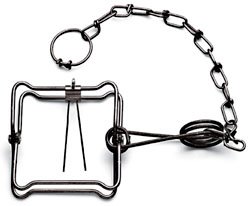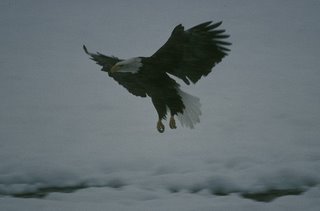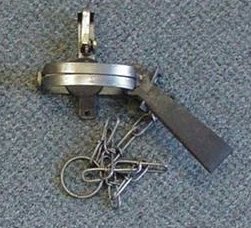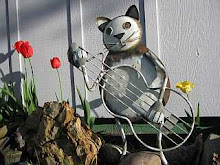
At the auction I had gotten 3 conibear traps and 5 leg hold traps. I used the conibear traps first.
 I had to be careful setting the conibear traps as the spring is very strong. In the photo the conibear trap is set.
I had to be careful setting the conibear traps as the spring is very strong. In the photo the conibear trap is set.What holds the trap open is a "trigger" and a "key". Each is on a separate metal square and when set against each other hold the trap open.
The "trigger" is the two small metal tines in the center of the trap attached to the small solid metal square.
The "key" holds the trap open until the trigger is tripped. The "key's" top is barely visible above the trigger. The key has 3 notches. One chooses which notch will go against the notch in the trigger. (So far I have always used the middle of the three notches). The trigger's notch is in the small square metal to which the two thin tines are attached.
When the trigger's tine is moved, the trigger's metal square is moved and the key will slide out of the trigger's notch. The key then no longer holds the two metal rods close together. The spring's arms will expand from being held-in-the-middle to each going-to-a-corner. The spring's movement causes the two metal rods to flip around with the opposite ends coming together.
If the trap was a circle and not a square, then think of the motion of the trap's rods going from set to tripped as creating a sphere. Any object inside and outside the sphere is caught and squeezed tightly by the metal rods.
The key and trigger both slide along the rods so one can position them at either end instead of the middle. Sometimes I place the trap partially in a gopher hole. Then I slide the trigger and key to one side of the trap to be where I think the gopher will come against it.
The spring is very strong and is hard to squeeze together. The spring snaps the trap shut quickly. I am careful when setting the trap so as not to have it trip and get my fingers inside. I have heard of fingers getting broken by one of these traps.
 Any gophers caught in the trap do not get out if the trap doesn't kill them instantly.
Any gophers caught in the trap do not get out if the trap doesn't kill them instantly.I have had only one trap trigger with no gopher caught. The tine is on one arm and when the trap is set the tine tends to be closer to one side (up or down) of the trap. Now I make sure to lay the trap so the tine is on the upper side of the trap so the gopher is more inside the trap and it's "sphere" when he/she moves the tine to trigger the trap. A second attempt caught a smaller sized gopher.
I decided to set the traps in the middle pasture as the cattle still are in the north pasture and I didn't want them stepping on the traps and either triggering them or bending or breaking them. It is one thing if they trigger the trap with their hooves. It is another matter if they trigger the trap by sniffing or licking it. I also warned Mr. D about the traps and suggested he keep his dogs out of my pasture for the time being.
The first time I set my conibear traps: after setting all three traps I then checked three of my gopher traps. Then I checked the first conibear trap. I had caught my first gopher.
I have found that after releasing the dead gopher from the trap the gopher will disappear entirely. Sometimes it is gone in less than a half an hour. I know it didn't walk off.

The chain and ring attached to the trap are apparently so another animal doesn't drag off the gopher and trap as I can't imagine a gopher moving much, unless only it's leg was caught. Even then the trap is larger than most gopher holes so it wouldn't disappear underground.
I have lost two of my three traps the past few days. I debated whether to explain the missing traps now or when I later write about a jailbreak by a few cattle as those were quite some days (one of several reasons I am behind in my blogging).
Here goes...
The evening of the jailbreak I also noticed a gopher was caught in one of my traps. I guess it came up to see what the commotion was about. As I had more important things to do, and seeing it was caught in it's middle and not going anywhere, I concentrated on the cattle.
 The next morning when using my binoculars to check on the two escapees down near the river an eagle flew across my view of the middle pasture. It landed in the pine tree near the bee hives. Cool! I haven't seen any eagles in a while.
The next morning when using my binoculars to check on the two escapees down near the river an eagle flew across my view of the middle pasture. It landed in the pine tree near the bee hives. Cool! I haven't seen any eagles in a while.I am not sure what kind of eagle it was. It was a large bird. It has a lighter color head and neck than the darker brown body. The tail feathers were also lighter. I don't remember any feathers on the legs.
I am not a bird expert by any means but the bird appears closer in looks to a bald eagle than a golden eagle. I'm not sure if there are any other kinds of eagles in Montana.
After the grass dried from the previous night's rain I went to check on the escapees. Walking by the gopher trap I noticed the gopher was gone - and so was the trap! What?!

The trap's chain and ring had been around a short (2 ft high) metal rod, and that was still in the ground but at an angle. I searched around the tall grass but could not find either the trap or the gopher. I believe the eagle or some other large bird flew off with my gopher and trap. It had to be a big bird as most gophers I had caught were a good size.
My other two traps were there. One was still set and empty; the other had a recently caught gopher which I finished off. Later that afternoon when in my garden I heard a commotion in the air. I looked up to see an eagle flying east across my hayfield then east across the road. A crow was following and harassing the eagle. The eagle was carrying in its claws a large limp gopher. I figured it found the dead gopher I recently tossed aside from my trap.
The next morning I checked my two remaining traps. One trap was gone. NO!!!
 The rod I had holding the chain was slightly at an angle but mainly upright. The rod was a yard tall and was in the shape of a cane (an inverted "J" at the top). To get the trap off one had to maneuver the chain ring up then down through the inverted "J". Other than man the only animal I know that may be able to do this is a large bird. The gophers in this area were on the smaller size so that may have helped the bird.
The rod I had holding the chain was slightly at an angle but mainly upright. The rod was a yard tall and was in the shape of a cane (an inverted "J" at the top). To get the trap off one had to maneuver the chain ring up then down through the inverted "J". Other than man the only animal I know that may be able to do this is a large bird. The gophers in this area were on the smaller size so that may have helped the bird.*Augh!*

Two traps lost in two days!! I removed the dead gopher from my final conibear trap then set the trap over a gopher hole under a tree. I also placed the tall "J" rod and a stick in the chain. Nothing was getting the chain off without removing both the rod and stick from the ground!
I have since found different rods with large ends or objects attached to the ends. The only way to remove the traps from the rod is to pull the rod out of the ground. Let's see that stupid eagle fly off with my traps now! Darn wildlife!

As I had seen the eagle fly east I gave up hope of finding the traps under one of my pasture trees. No wonder I started to see the eagle after I started trapping gophers. I read that eagles are not big on eating carrion unless they have to. I bet this eagle has babies and mouths to feed and could use the extra meat. It probably circles overhead waiting for me to set the traps. I have seen the eagle a few more times, each time several smaller birds were chasing and harassing the eagle as it flew over my pasture.
 I have lots of gophers left to trap. I took a look at the remaining five traps I had bought at the auction: the leg hold traps. They didn't look like they would hold a gopher. Most of these gophers are plenty big and strong.
I have lots of gophers left to trap. I took a look at the remaining five traps I had bought at the auction: the leg hold traps. They didn't look like they would hold a gopher. Most of these gophers are plenty big and strong.I also wasn't too excited by this trap as its spring isn't as powerful as the spring on the conibear traps. Still I tried the trap. I put all five out last night and found I had two gophers when I first checked the traps today.
This photo shows the trap closed. The spring on these traps is the long rectangle on the right side. I step on the spring pushing the top of it down to the bottom. Then I can separate the two half circles to lay flat.
The trigger is the round metal circle under the two half circles. It has a notch on one side. The long thin piece of metal at the top of the photo goes over one of the half circles and goes into the notch to hold the trap open. When the gopher steps on the round circle the circle goes down and metal catch falls backward and away from the circle. The pressure is released on the half circle and it goes up to standing position as the spring expands and moves up. When the spring is down the other half circle easily moves up or down. When the spring moves up it forces the two half circles together.
A gopher leg is what triggers the trap and the leg is caught between the two half circles. The last gopher I caught had both front legs in the trap. Of the other gophers some had a front leg in the trap; others had a back leg trapped.
A downside of this trap is that it doesn't kill the gophers so I had to do the dirty deed. Also the chain and ring are important as this trap is smaller than a conibear trap and when closed some traps could fit into a large sized gopher hole. With three legs free I found the trap only remained in place because of the rods I had in the ground to hold the trap. In most cases the gopher pulled the chain tight and was partially in the hole and I had to pull it out. Needless to say the gophers were not pleased. One verbally chewed me out as I pulled it and the trap from the hole. Another thrashed around trying to get me as it swung from the chain until I could dispatch it.
I am happy these leg hold traps work, but I prefer the conibear traps as that trap literally took the life and fight out of the gophers. In one day with the leg hold traps I caught 5 gophers with the five traps. Several traps/gopher holes had no activity so the five caught were because I checked the traps three times today.
I have found - unlike pocket gophers that are solitary animals unless it is the breeding season - multiple gophers live in the holes. Usually there are a number of holes in a short area. When setting the trap I try to fill/close the surrounding holes. After dispatching the dead gopher I fill this hole in. Always by the next day this and most of the surrounding holes are open and free of dirt. I place the trap there again and get another gopher, then another one. For each trap I have been switching back and forth between several holes in trapping gophers.
I wonder if the gophers are catching on that I am a "bad" guy. Lately they have been chirping warnings when I am further away than in the past.

Those pesky pocket gophers are still around. I trapped a gopher early this afternoon and by evening found fresh pocket gophers dirt mounds nearby as one quickly moved into the neighborhood now that the gopher was gone. The pocket gopher's mistake as I got it before I quit for the night. Looked to be a "teenager" just out on its own judging from the smaller size.
And yes, my count of trapped gophers includes the two missing traps and gophers.


No comments:
Post a Comment